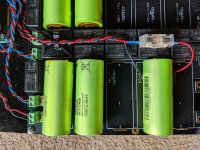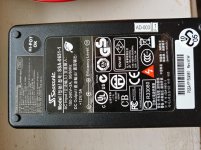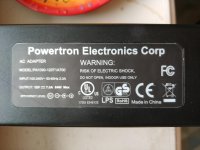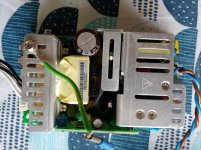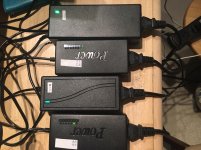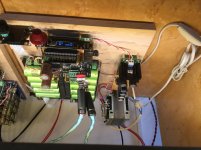@nielsek
"5 seconds the Lifepo4 unit is charging and then 5 seconds pending"
With battery cells installed, the OLED won't be like this.
Any 0.015ohm resistor that had smoke needs to be replaced.
Regards,
Ian
"5 seconds the Lifepo4 unit is charging and then 5 seconds pending"
With battery cells installed, the OLED won't be like this.
Any 0.015ohm resistor that had smoke needs to be replaced.
Regards,
Ian
Thank you Greg and Simon for your suggestions, it helped track down what was going on.
It didn't make sense because the batteries all measured fine with it OFF, but when running, 2 cells measured 0 vdc. So that immediately told me either a faulty battery or holder. I tried swapping positions of those two cells and the zero volts situation moved with the suspect cells, so now I'm wondering how 2 out of 10 brand new cells could be bad?
Further testing with the unit running showed when putting the test leads on the holder terminals there was 0 vdc, BUT when you moved the leads in a bit and contacted the battery itself, then it was reading 3.3 vdc. What the heck!
It turns out 2 of my batteries were not making contact on the negative terminal in the holder due to the plastic center being slightly raised above the negative contact surface. See photo attached. These 2 cells were carefully corrected with an xacto knife.
Thanks Heathkit. This was the issue. In charge/off mode the (+) terminals are apparently connected which was why it measured +3.3V, but 0V in on mode. I'm still having an issue with the board (loud ground hum compared to the other boards I have) but at least the output voltages are correct now.
Thanks Greg. I did look for .015R resistor PN but couldn't find it. Did order these ones WW20NR015FTL WALSIN - Resistor: power metal | TME - Electronic components, 2010 casing.
As I'm not using the 3.3V-13.2V rails, could I just swap one .015R resistor from there, until I have sourced for new one?
Concerning testing different power supplies (12V > 19V), the other LiFePO4 unit fully loaded with 10 batteries works correctly with all my 12V supplies. Of course I will proceed with testing different AC-DC adapters. I just don't think the whistling noise is caused by that.
The lab supply I have, probably didn't have enough power. I did test it with full stack (2 LiFePO4 units and 12 batteries).
Thanks for the help, hopefully I'm able to replace the resistor and test more.
I have that same annoying high pitched whine while charging on all my boards with the supplies I have. When charging it usually runs around 5-6 amps.
Whistling noise? Is that from the charging convertor and if so what's the circuit. I know a little so might be able to make some suggestions as to how to make it go away.
Whistling noise? Is that from the charging convertor and if so what's the circuit. I know a little so might be able to make some suggestions as to how to make it go away.
I tried to listen putting ear very close and it seemed to come from relays in center of the board.
@nielsek, thanks for the info that your 19V lab supply doesn't cause the noise.
@nielsek & @alazira, can you give us more info on the supplies that are causing the noise? Type, make, manufacturer (if not DIY'd), pix? AND anything else you can think of that might be useful?
Finally, @nielsek, you wrote: "...I thought I need 3 additional rails for the DAC, but 2 was enough, so I just used BT6/7."
Do you still have any other cells installed on the board?
THANKS!
Greg in Mississippi
@nielsek & @alazira, can you give us more info on the supplies that are causing the noise? Type, make, manufacturer (if not DIY'd), pix? AND anything else you can think of that might be useful?
Finally, @nielsek, you wrote: "...I thought I need 3 additional rails for the DAC, but 2 was enough, so I just used BT6/7."
Do you still have any other cells installed on the board?
THANKS!
Greg in Mississippi
Last edited:
@nielsek & @alazira, can you give us more info on the supplies that are causing the noise? Type, make, manufacturer (if not DIY'd), pix? AND anything else you can think of that might be useful?
Finally, @nielsek, you wrote: "...I thought I need 3 additional rails for the DAC, but 2 was enough, so I just used BT6/7."
Do you still have any other cells installed on the board?
Will send then supplies data next week, not at home now.
I have just the 2 batteries installed, but can test with more, if needed.
Extra 3v3 from LiFePO4 board hack
Here's a hack for those who aren't running an active IV and would find an extra 3v3 supply or two useful.
Two of the board's outputs can be configured as series 'strings' of batteries to get higher voltages. You can fit Bat 3 and or Bat 9 and use the series link holes to pick up additional isolated 3v3 by using the 'gap' in the series string.
The additional batteries will be protected and monitored in charge mode but not when switched to on mode. Therefore you will now need to fuse the output as you are not relying on the on board protection.
This will not work for anything other than all 3v3 configurations only.
Check everything is as you would expect before committing!
Safety disclaimer! If you need to ask a lot of questions about this hack it's probably not for you.
Here's a hack for those who aren't running an active IV and would find an extra 3v3 supply or two useful.
Two of the board's outputs can be configured as series 'strings' of batteries to get higher voltages. You can fit Bat 3 and or Bat 9 and use the series link holes to pick up additional isolated 3v3 by using the 'gap' in the series string.
The additional batteries will be protected and monitored in charge mode but not when switched to on mode. Therefore you will now need to fuse the output as you are not relying on the on board protection.
This will not work for anything other than all 3v3 configurations only.
Check everything is as you would expect before committing!
Safety disclaimer! If you need to ask a lot of questions about this hack it's probably not for you.
Attachments
@nielsek & @alazira, can you give us more info on the supplies that are causing the noise? Type, make, manufacturer (if not DIY'd), pix? AND anything else you can think of that might be useful?
Greg in Mississippi
I will take a pic of the power supplies. I have a couple more I haven't used, so will see if those have different results. The noise is less when the Oled turns off.
@nielsek,
Can you try a laptop adapter around 18.5V capable for 4A or higher?
The charging current can go up to 10A. I think your current adapter doesn't have enough power for more battery cells.
Ian
If the adapter doesn't have enough power for more battery cells, the voltage should drop suddenly, the entire module should stop working, stop charging?
I have that same annoying high pitched whine while charging on all my boards with the supplies I have. When charging it usually runs around 5-6 amps.
High frequency noise can come from inductors or capacitors. When the internal electrolyte of the electrolytic capacitor is changed, it is difficult to judge from the appearance, and it cannot be measured by a electric meter or a capacitance meter.
@nielsek
"5 seconds the Lifepo4 unit is charging and then 5 seconds pending"
With battery cells installed, the OLED won't be like this.
Any 0.015ohm resistor that had smoke needs to be replaced.
Regards,
Ian
Thank you Ian!
Changed the burnt resistor and not switching anymore between charging and pending. Seems to work well.
Attached are some photos of 12V chargers I used and they all whistled. The last one's model I couldn't figure out.@nielsek & @alazira, can you give us more info on the supplies that are causing the noise? Type, make, manufacturer (if not DIY'd), pix? AND anything else you can think of that might be useful?
Today I got a 19V adapter and no whistle.
Thanks!
Attachments
When works with lower voltage DC adapter, the demand current would be much higher than the higher voltage DC power when the LifePO4 in charging or pending states. If the the DC adapter is a switching mode power supply, some times it can generate audible noise in some cases, either at DC adapter or at LifePO4 board. But normally it still fully functional. But I'm highly suggest replacing it with a better DC adapter that without any audible noise.Either higher voltage or better quality.
Regards,
Ian
Regards,
Ian
As I wrote it is working perfectly, so why change it? It is quit, without any hf rubbish that most switching ps put out.
I also used a 19v switching ps that has ruined a sparkos opamp so won’t try that one again.
I can follow your explanation that a lower voltage will increase the current draw, after all it is a certain power that is needed. But I have used another switching ps at 15v that also draw 5,5amps when charging. So there is probably some other factor limiting the current draw.
I have experienced that I can run all day (12-14 hours) on the battery pack, nice!
I also used a 19v switching ps that has ruined a sparkos opamp so won’t try that one again.
I can follow your explanation that a lower voltage will increase the current draw, after all it is a certain power that is needed. But I have used another switching ps at 15v that also draw 5,5amps when charging. So there is probably some other factor limiting the current draw.
I have experienced that I can run all day (12-14 hours) on the battery pack, nice!
Last edited:
@Supersurfer
What you mentioned the 5.5amps is the battery charging current which is deiced by the smart charger chip, so that's why normally it doesn't change under same battery cells conditions,even you change the voltage of the DC adapter. This current is totally different to the current of the output of the DC adapter.
If everything is in linear, then the two current should be very close to each other. But actually they work at switching mode, so you need to think it in a different way.🙂
Regards,
Ian
What you mentioned the 5.5amps is the battery charging current which is deiced by the smart charger chip, so that's why normally it doesn't change under same battery cells conditions,even you change the voltage of the DC adapter. This current is totally different to the current of the output of the DC adapter.
If everything is in linear, then the two current should be very close to each other. But actually they work at switching mode, so you need to think it in a different way.🙂
Regards,
Ian
Understood.
Anyway the ps works fine so I will keep it. At least until the second battery board arrives and I put it in parallel with the other one.........
Anyway the ps works fine so I will keep it. At least until the second battery board arrives and I put it in parallel with the other one.........
- Home
- Amplifiers
- Power Supplies
- Develop ultra capacitor power supply and LiFePO4 battery power supply
